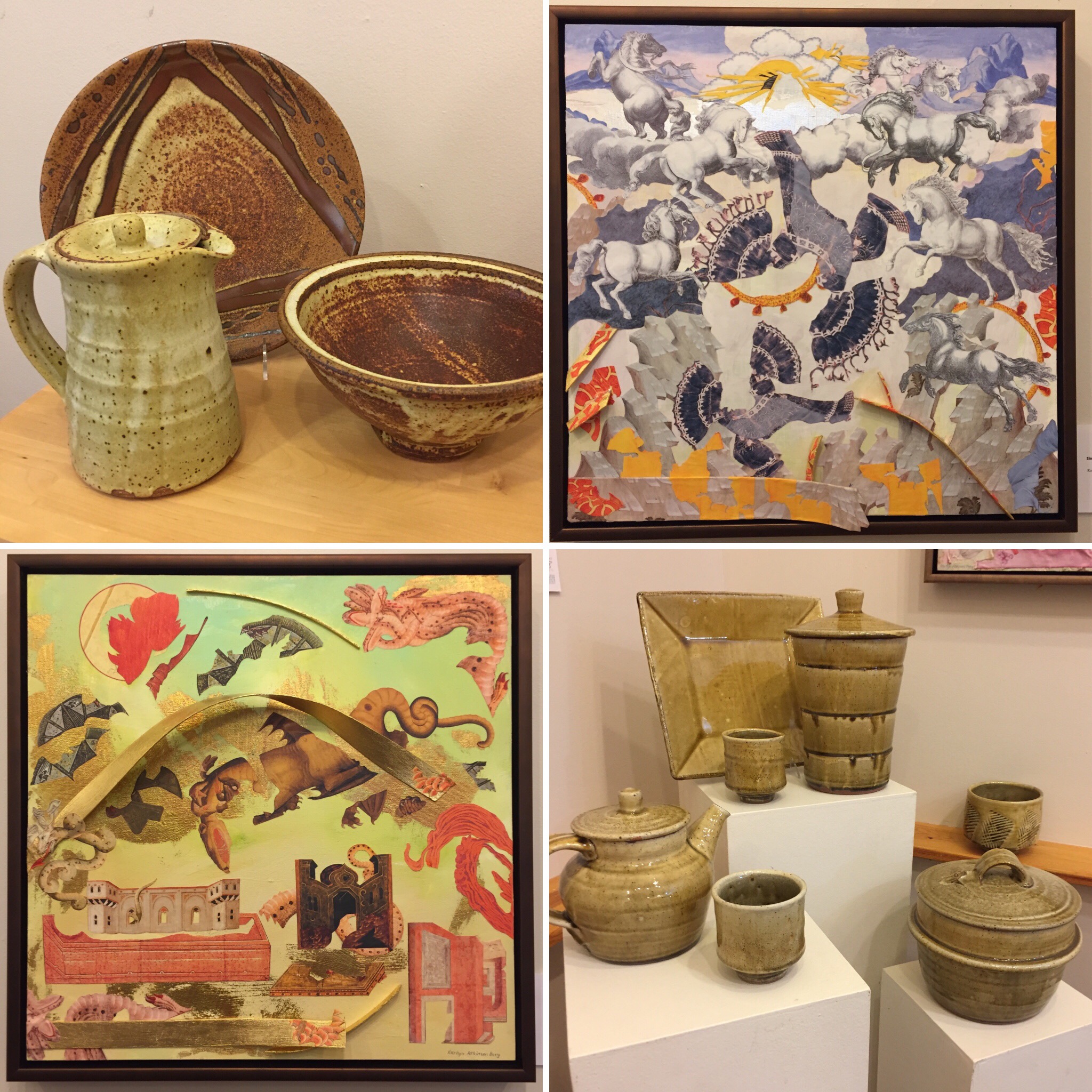
13 Aug Collage and clay…
Collage and clay by two artists will be featured at Ripple River Gallery beginning July 15. While collage paintings by Karlyn Atkinson Berg and pottery by Guillermo Cuellar might seem to have little in common, work by both artists reflects their devotion to process and their passion for their craft. The show will continue through August 16 at the gallery near Bay Lake.
In her series, “Uncertain Realms,” Karlyn Atkinson Berg explored new ways to challenge herself as a collage artist. “It becomes very easy to create within an established comfort zone where you employ a favorite color theme, a style, image components, or safe repetitive formula for your paintings,” she said. “I always attempt to break out of that comfort zone even if it means a risk.”
“Working on a collage is always an exciting visual journey offering a multitude of possibilities,” Atkinson Berg said. More than a mere assembly of pictures, collage is an art form that allows the artist to combine a multitude of shapes, objects, color and pieces to form a painting or sculptural assemblage. Each added element builds on the previous one by changing, adding or even eliminating the other components. For “Uncertain Realms” Atkinson Berg challenged herself to include steamed and shaped bent wood components to add a three-dimensional element to her collage.
“With each panel I experimented with different paint textures and color palettes and wrestled to maintain quality design and execution to create accomplished paintings,” she said. “The challenge was integrating the three-dimensional components to move effectively with the whole composition. Because I approached each panel as a different investigation, I risked not having a cohesive group of paintings. I have to rely that my voice as a painter remained sound though each work was different.”
“I hope these paintings transport the viewer into a mystery of the color and the imagined worlds.”
Atkinson Berg graduated from Rhode Island School of Design, continued her studies at Pratt University and worked at the Metropolitan Museum of Art. She was awarded grants from the Minnesota State Arts Board in 2017 and 2020 and from the Arrowhead Regional Arts Council in 2018 and 2019. She is currently administrative assistant at the Edge Center for the Arts in Bigfork.
Karlyn Atkinson Berg is a fiscal year 2019 recipient of a grant from the Arrowhead Regional Arts Council. This activity was made possible in part by the voters of Minnesota through a grant from the Arrowhead Regional Arts Council, thanks to appropriations from The McKnight Foundation and the Minnesota State Legislature’s general and arts and cultural heritage funds.
In 1980 Guillermo Cuellar began making pots for a living in his home country of Venezuela. During a workshop in Caracas in 1981, chance led to a formative experience as an assistant to Minnesota potter, the late Warren MacKenzie. “Visiting his studio and home over the years I saw the most beautiful pots, old and new, that I had ever seen. The kinship I continue to feel with that work, with Warren’s life and his work, and the historical sweep of useful pottery making informs my work to this day,” Cuellar says.
After working, exhibiting and teaching in Venezuela for 25 years, Cuellar set up a pottery studio in Shafer, Minnesota in 2005. In addition to making pots full time he has exhibited, taught workshops and juried exhibitions. Since 2009 he has been a host studio on the annual St. Croix Valley Pottery Tour. Though primarily a maker, he is also committed to mentoring and teaching and currently has two apprentices.
“I love to make pots that invite handling and use, that suggest participation and enjoyment, not only contemplation. Pots are tactile as well as visual and are felt physically,” Cuellar said. “Beauty also has a function, which is to make a piece engaging to the user. I think good pots are associated with what I see as important priorities in living a good life and balancing the rough edges of contemporary life. I hope my pots will encourage folks to slow down, cook, and share their own delicious food and drink in good company.”




Sorry, the comment form is closed at this time.